Characterization of Machined Surface Topography Based on the Normal Declination Angle of Microfacets
Abstract
1. Introduction
2. The Characterization Method for Surface Topography
3. Measurement and Analysis of the Machined Surface Topography
3.1. Measuring Equipment and Methods
3.2. Measurement Results
3.3. Analysis of Machined Surface Topography
4. Characterization Model of Machined Surface Topography
4.1. Lognormal Distribution Characterization Model
4.2. Parameters of Characterization Model
4.3. Model Validation and Error Analysis
5. Conclusions
Author Contributions
Funding
Acknowledgments
Conflicts of Interest
References
- Zhang, X.; Zhang, W.; Zhang, J.; Pang, B.; Zhao, W. Systematic study of the prediction methods for machined surface topography and form error during milling process with flat-end cutter. Proc. Inst. Mech. Eng. Part B: J. Eng. Manuf. 2017, 233, 226–242. [Google Scholar] [CrossRef]
- Xu, D.; Yang, Q.; Wang, X.C.; He, H.; Sun, Y.Z.; Li, W.P. An Experimental Investigation of Steel Surface Topography Transfer by Cold Rolling. Micromachines 2020, 11, 916. [Google Scholar] [CrossRef] [PubMed]
- Zhang, J.F.; Feng, C.; Wang, H.; Gong, Y.D. Analytical Investigation of the Micro Groove Surface Topography by Micro-Milling. Micromachines 2019, 10, 582. [Google Scholar] [CrossRef]
- Lesyk, D.A.; Martinez, S.; Mordyuk, B.N.; Dzhemelinskyi, V.V.; Lamikiz, A.; Prokopenko, G.I. Effects of laser heat treatment combined with ultrasonic impact treatment on the surface topography and hardness of carbon steel AISI 1045. Opt. Laser Technol. 2019, 111, 424–438. [Google Scholar] [CrossRef]
- Gropper, D.; Wang, L.; Harvey, T.J. Hydrodynamic lubrication of textured surfaces: A review of modeling techniques and key findings. Tribol. Int. 2016, 94, 509–529. [Google Scholar] [CrossRef]
- Gachot, C.; Rosenkranz, A.; Hsu, S.M.; Costa, H.L. A critical assessment of surface texturing for friction and wear improvement. Wear 2017, 372, 21–41. [Google Scholar] [CrossRef]
- Grabon, W.; Pawlus, P. Improvement of the Rpq parameter calculation. Measurement 2018, 129, 236–244. [Google Scholar] [CrossRef]
- Kulesza, S.; Bramowicz, M. A comparative study of correlation methods for determination of fractal parameters in surface characterization. Appl. Surf. Sci. 2014, 293, 196–201. [Google Scholar] [CrossRef]
- An, Q.L.; Cai, C.Y.; Zou, F.; Liang, X.; Chen, M. Tool wear and machined surface characteristics in side milling Ti6Al4V under dry and supercritical CO2 with MQL conditions. Tribol. Int. 2020, 151, 106511. [Google Scholar] [CrossRef]
- Li, L.; Tang, J.Y.; Wen, Y.Q.; Shao, W. Characterization of ultrasonic-assisted grinding surface via the evaluation of the autocorrelation function. Int. J. Adv. Manuf. Technol. 2019, 104, 9–12. [Google Scholar] [CrossRef]
- Li, Z.H.; Zheng, K.; Liao, W.H.; Xiao, X.Z. Surface characterization of zirconia ceramics in ultrasonic vibration-assisted grinding. J. Braz. Soc. Mech. Sci. Eng. 2018, 40, 379. [Google Scholar] [CrossRef]
- Chen, H.F.; Tang, J.Y.; Shao, W.; Zhao, B. An investigation on surface functional parameters in ultrasonic-assisted grinding of soft steel. Int. J. Adv. Manuf. Technol. 2018, 97, 2697–2702. [Google Scholar] [CrossRef]
- Li, C.S.; Sun, L.; Yang, S.M.; Zhang, L.C.; Wu, C.H.; Jiang, Z.D. Three-dimensional characterization and modeling of diamond electroplated grinding wheels. Int. J. Mech. Sci. 2018, 144, 553–563. [Google Scholar] [CrossRef]
- Panda, S.; Chowdhury, S.K.R. Effects of non-Gaussian counter-surface roughness parameters on wear of engineering polymers. Wear 2015, 332, 827–835. [Google Scholar] [CrossRef]
- Pawlus, P.; Reizer, R.; Wieczorowski, M. Characterization of the shape of height distribution of two-process profile. Measurement 2020, 153, 107387. [Google Scholar] [CrossRef]
- Krolczyk, G.M.; Maruda, R.W.; Krolczyk, J.B.; Nieslony, P.; Wojciechowski, S.; Legutko, S. Parametric and nonparametric description of the surface topography in the dry and MQCL cutting conditions. Measurement 2018, 121, 225–239. [Google Scholar] [CrossRef]
- Guo, J.; Guo, Y.W.; Pan, J.G. A retroreflective BRDF model based on prismatic sheeting and microfacet theory. Graph. Models 2018, 96, 38–46. [Google Scholar] [CrossRef]
- Murphy, A.B. Modified Kubelka-Munk model for calculation of the reflectance of coatings with optically-rough surfaces. J. Phys. D: Appl. Phys. 2006, 39, 3571–3581. [Google Scholar] [CrossRef]
- Yang, M.; Xu, W.B.; Sun, Z.Y.; Jia, A.J.; Xiu, P.; Chen, W.L.; Li, L.T.; Zheng, C.; Li, J.W. Degree of polarization modeling based on modified microfacet pBRDF model for material surface. Opt. Commun. 2019, 453, 124390. [Google Scholar] [CrossRef]
- Menees, D.D.; Melin, P.; Campo, L.; Rozenbaum, O.; Cosson, L. Probing high temperature thermal emissive properties of energy materials and coatings with emission spectroscopy augmented by in situ reflection. Infrared Phys. Technol. 2020, 108, 103329. [Google Scholar] [CrossRef]
- Wang, F.Y.; Pang, W.C.; Fang, Y.; Jiang, Y.J.; Han, L.L.; Li, Y.L. Comparative Research on Mechanical Properties and Void Distribution of Cement Stabilized Macadam Based on Static Pressure and Vibration Compaction. Appl. Sci. 2020, 10, 8830. [Google Scholar] [CrossRef]
- Rza, W.; Ma, S.B.; Kim, K.Y. Multi-Objective Optimizations of a Serpentine Micromixer with Crossing Channels at Low and High Reynolds Numbers. Micromachines 2018, 9, 110. [Google Scholar] [CrossRef]
- Pawlus, P.; Reizer, R.; Wieczorowski, M. Conditions of the Presence of Bimodal Amplitude Distribution of Two-Process Surfaces. Materials 2020, 13, 4037. [Google Scholar] [CrossRef] [PubMed]
- Guo, R.P.; Tao, Z.S. The modified Beckmann-Kirchhoff scattering theory for surface characteristics in-process measurement. Opt. Lasers Eng. 2009, 47, 1205–1211. [Google Scholar] [CrossRef]
- Minet, C.; Brunetiere, N.; Tournerie, B.; Fribourg, D. Analysis and Modeling of the Topography of Mechanical Seal Faces. Tribol. Trans. 2010, 53, 799–815. [Google Scholar] [CrossRef]
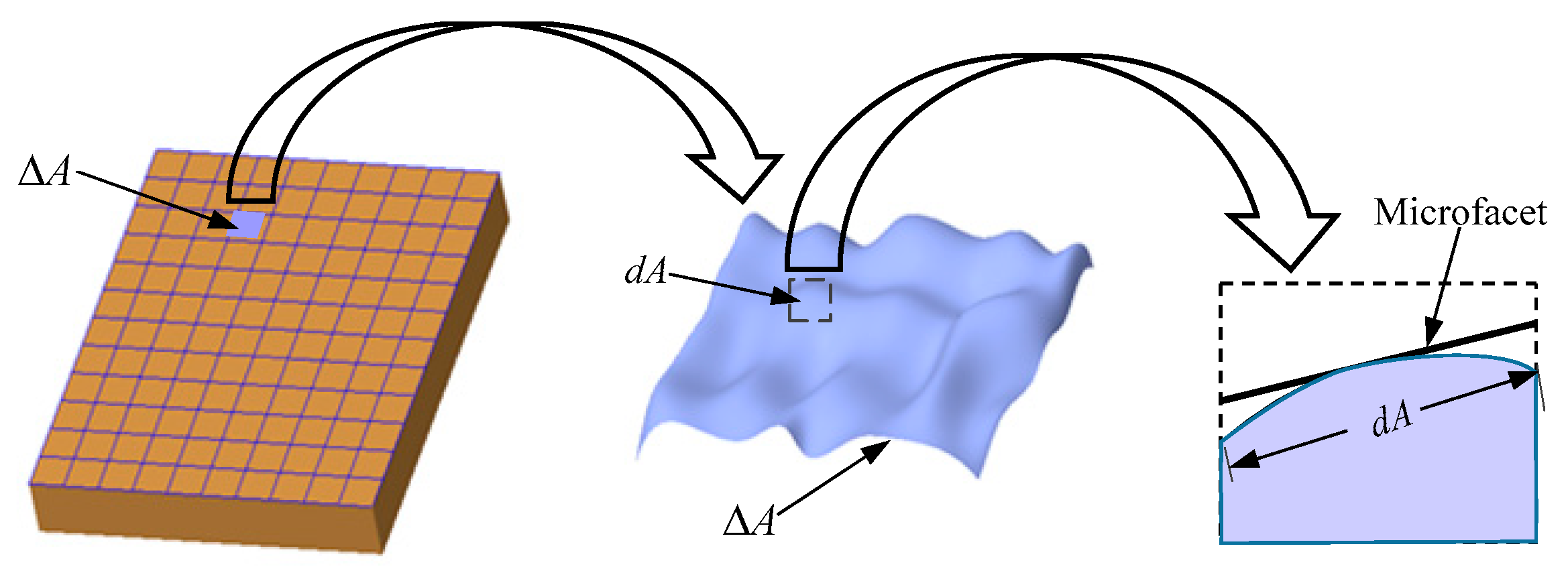


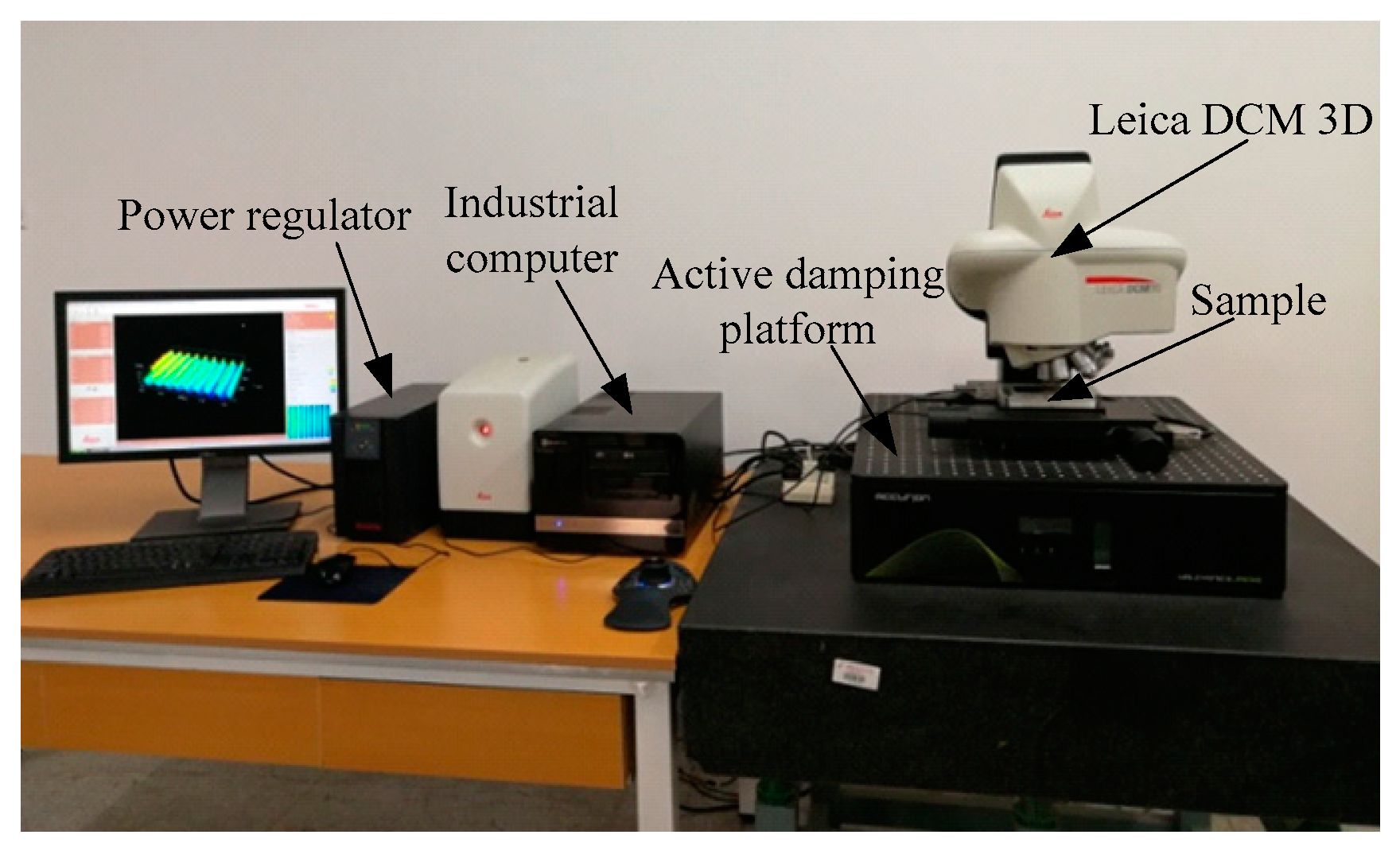

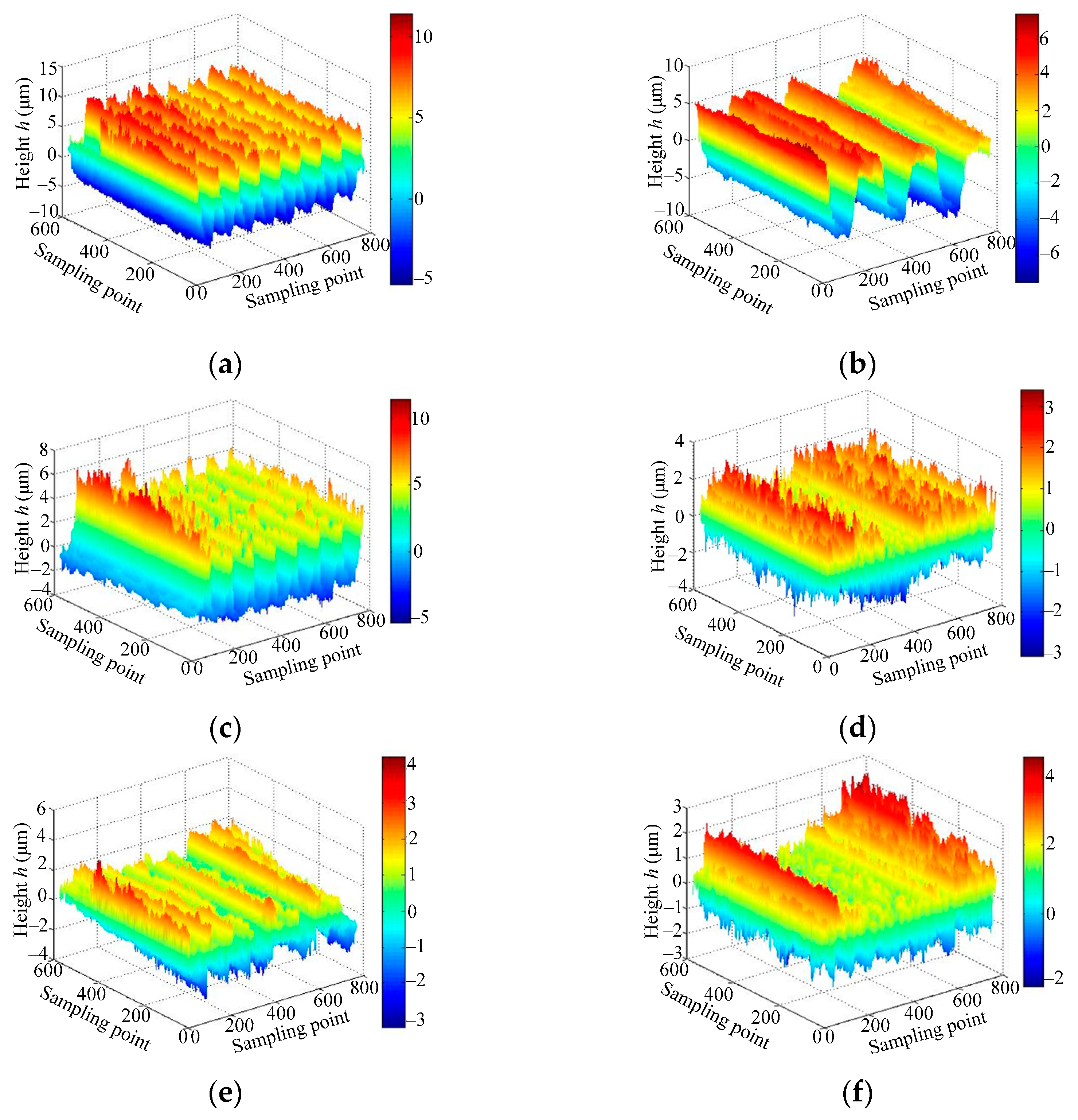

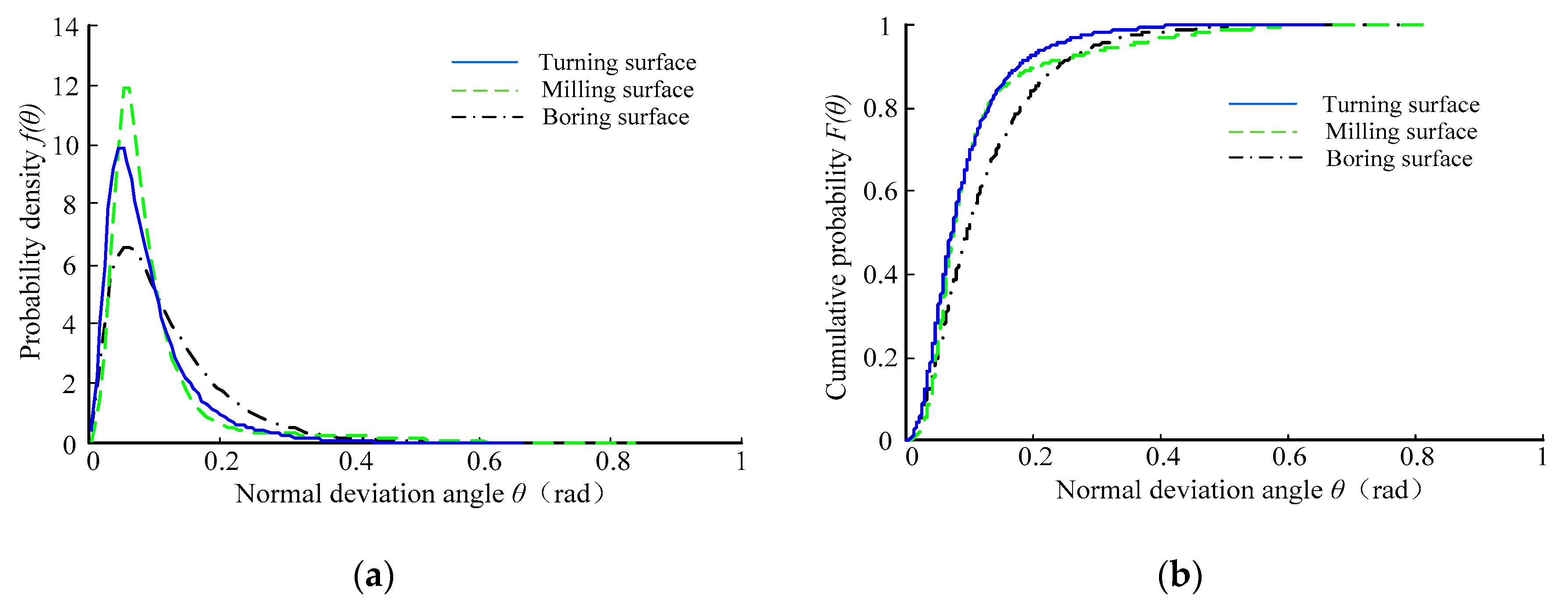
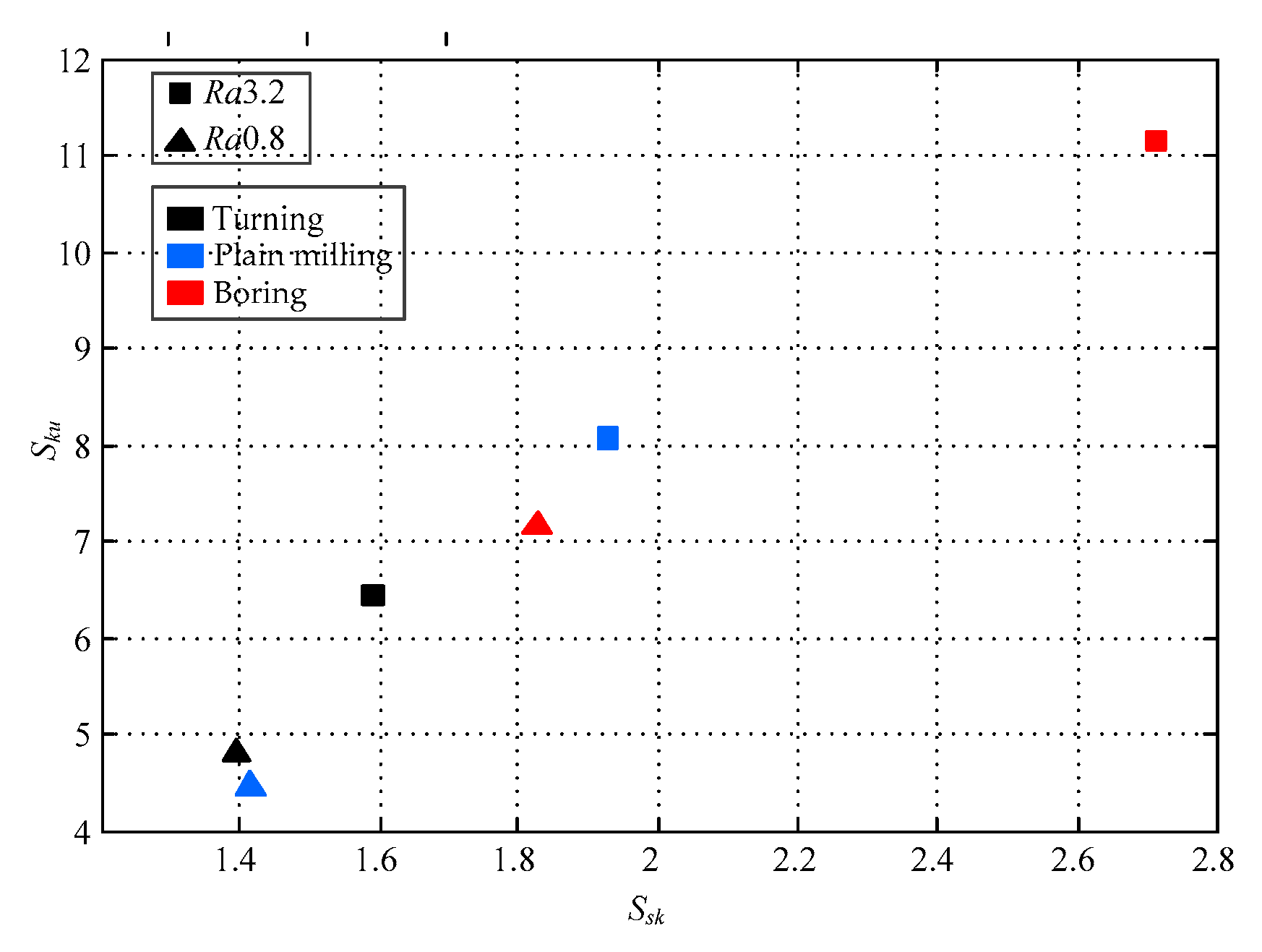
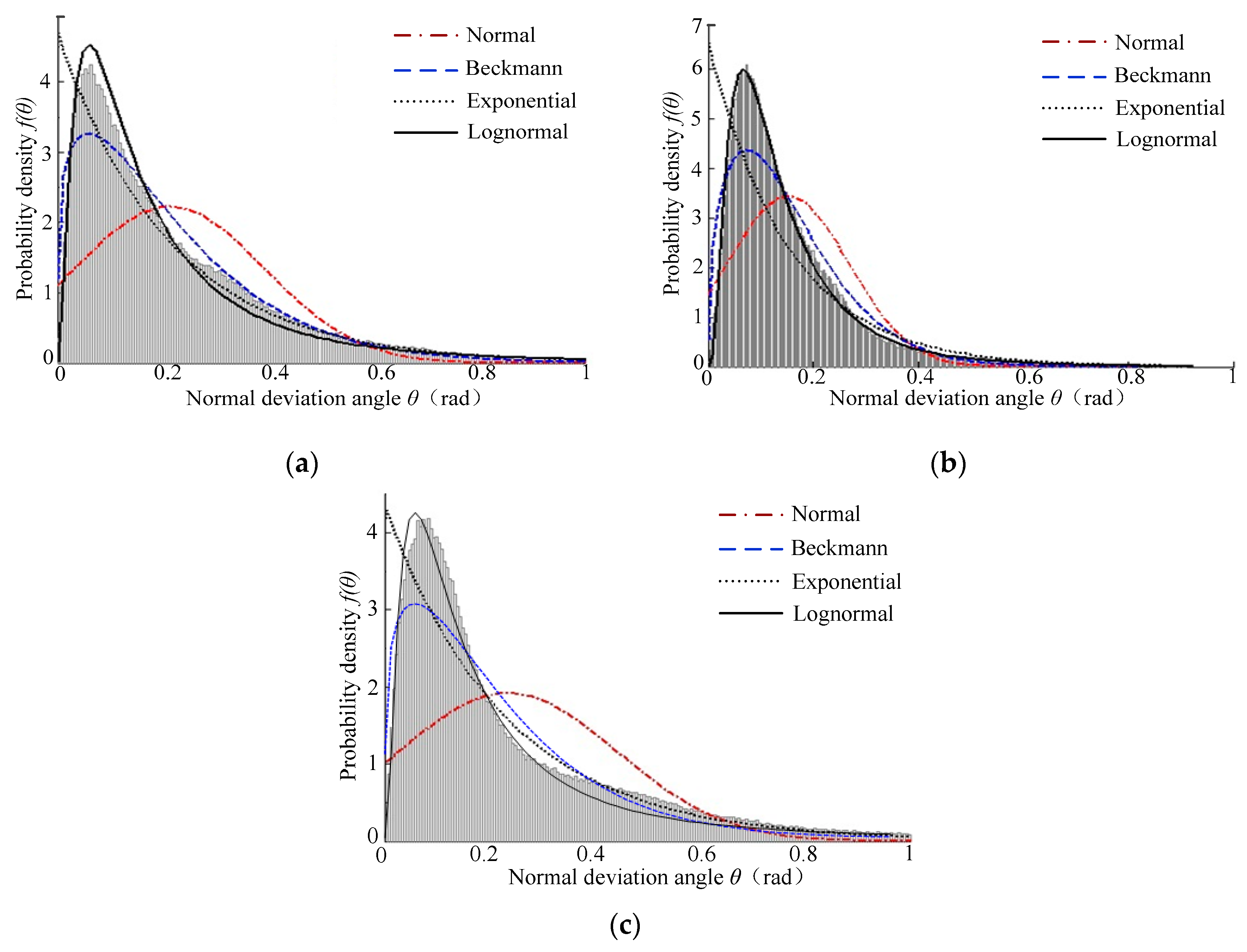
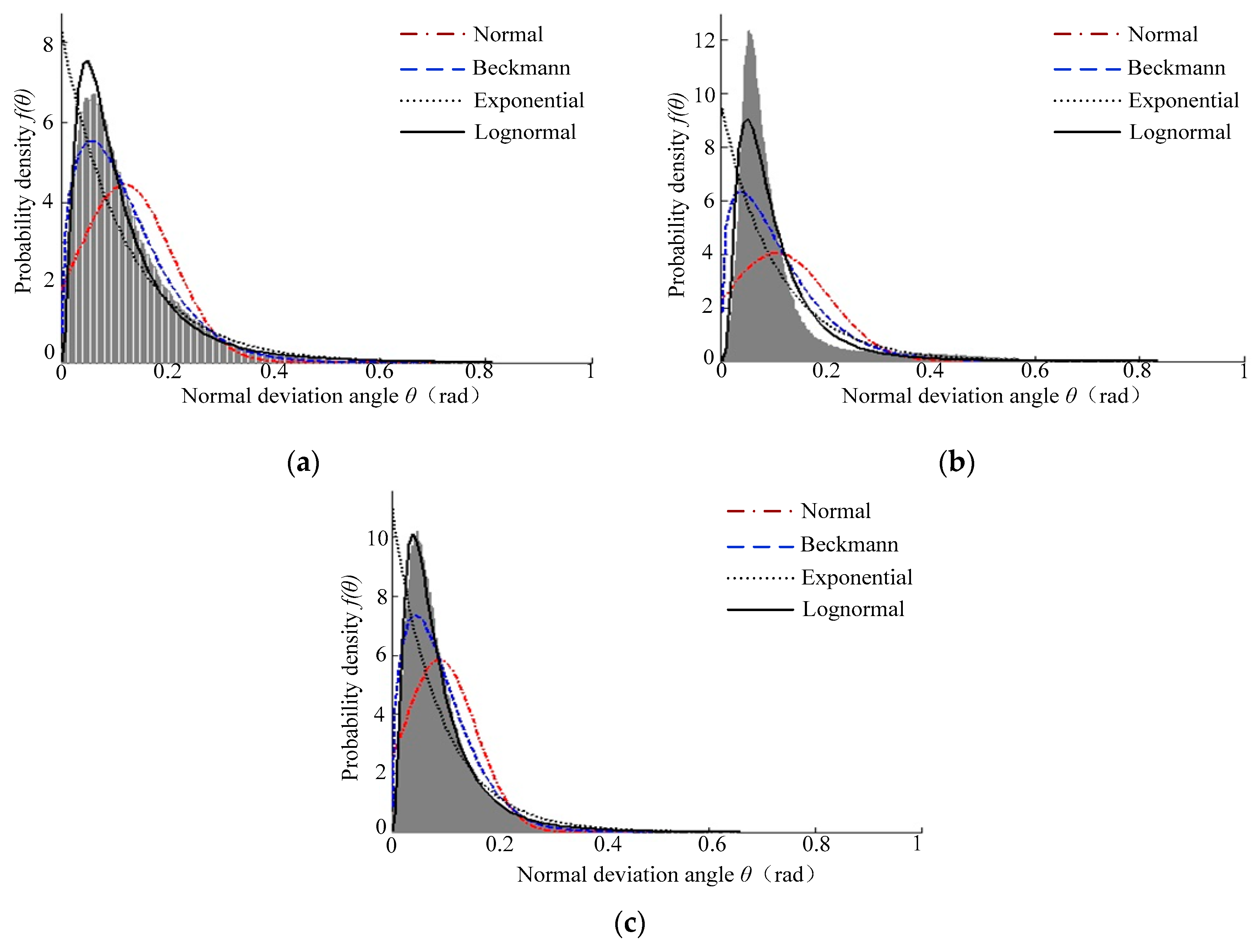
| General Outlines for the Adopted Characteristic Index | The Normal Declination Angle of the Microfacets Is Denoted by θi, Where i = 1, 2, …n. |
|---|---|
| Arithmetic average (μ) | |
| Standard declination (σ) | |
| Skewness (S) | When S = 0, the probability density curve is normal. When S < 0, the probability density curve is left-skewed. When S > 0, the probability density curve is right-skewed. |
| Kurtosis (K) | When K < 3, the normal skew angle distribution curve presents a low peak state; when K > 3, the normal skew angle distribution curve presents a sharp peak feature. |
| Surface Type | Arithmetic Average | Standard Declination | Skewness | Kurtosis | |
|---|---|---|---|---|---|
| Turning | 0.213 | 0.179 | 1.394 | 4.814 | |
| Plain milling | 0.152 | 0.116 | 1.827 | 7.176 | |
| Boring | 0.232 | 0.207 | 1.414 | 4.474 | |
| Surface Type | Arithmetic Average | Standard Declination | Skewness | Kurtosis |
|---|---|---|---|---|
| Turning | 0.12 | 0.089 | 1.591 | 6.448 |
| Plain milling | 0.106 | 0.068 | 2.714 | 11.152 |
| Boring | 0.091 | 0.090 | 1.926 | 8.08 |
| Surface Type | Ra 3.2 | Ra 0.8 | ||
|---|---|---|---|---|
| a | b | a | b | |
| Turning | 1.06 | −1.92 | 1.21 | −2.41 |
| Plain milling | 1.33 | −2.14 | 1.42 | −2.52 |
| Boring | 1.36 | −2.65 | 1.57 | −2.71 |
| Characterization Model | Normal Distribution | Beckmann Distribution | Exponential Distribution | Lognormal Distribution |
|---|---|---|---|---|
| Expression |
| Roughness | Surface Type | ME | RMSE |
|---|---|---|---|
| Ra 3.2 | Turning | 0.224 | 0.024 |
| Plain milling | 0.112 | 0.009 | |
| Boring | 0.209 | 0.021 | |
| Ra 0.8 | Turning | 0.217 | 0.021 |
| Plain milling | 0.264 | 0.045 | |
| Boring | 0.106 | 0.006 |
Publisher’s Note: MDPI stays neutral with regard to jurisdictional claims in published maps and institutional affiliations. |
© 2021 by the authors. Licensee MDPI, Basel, Switzerland. This article is an open access article distributed under the terms and conditions of the Creative Commons Attribution (CC BY) license (http://creativecommons.org/licenses/by/4.0/).
Share and Cite
Shi, W.-C.; Zheng, J.-M.; Wang, Q.-L.; Wang, L.-J.; Li, Q. Characterization of Machined Surface Topography Based on the Normal Declination Angle of Microfacets. Micromachines 2021, 12, 228. https://doi.org/10.3390/mi12030228
Shi W-C, Zheng J-M, Wang Q-L, Wang L-J, Li Q. Characterization of Machined Surface Topography Based on the Normal Declination Angle of Microfacets. Micromachines. 2021; 12(3):228. https://doi.org/10.3390/mi12030228
Chicago/Turabian StyleShi, Wei-Chao, Jian-Ming Zheng, Qi-Long Wang, Li-Jie Wang, and Qi Li. 2021. "Characterization of Machined Surface Topography Based on the Normal Declination Angle of Microfacets" Micromachines 12, no. 3: 228. https://doi.org/10.3390/mi12030228
APA StyleShi, W.-C., Zheng, J.-M., Wang, Q.-L., Wang, L.-J., & Li, Q. (2021). Characterization of Machined Surface Topography Based on the Normal Declination Angle of Microfacets. Micromachines, 12(3), 228. https://doi.org/10.3390/mi12030228





